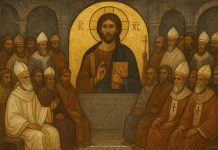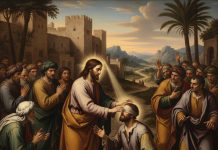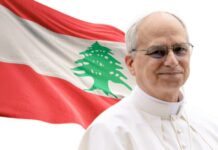Faith Reflections on the Meaning and Background of All Souls’ Day
Elias Bejjani/November 02/2025
تأملات إيمانية في معاني وخلفيات يوم تذكار جميع الموتى المؤمنين
الياس بجاني/02 تشرين الثاني/ 2025
تحتفل الكنيسة الكاثوليكية بـ “تذكار جميع الموتى المؤمنين” في الثاني من شهر تشرين الثاني من كل سنة. هذا اليوم هو مناسبة إيمانية للصلاة بخشوع وتقوى لراحة أنفس الموتى المؤمنين، فما هي خلفيات هذا الاحتفال الكنسي الإيماني، وما هي مفاهيمه ومعانيه الروحية التي تدعونا إلى الصلاة والرجاء؟
1. معاني اليوم المقدس وأهميته الإيمانية
يُعرف هذا اليوم في الكنيسة الكاثوليكية باسم “تذكار جميع الموتى المؤمنين”، ويُحتفل به في الثاني من شهر تشرين الثاني (نوفمبر) من كل عام، مباشرة بعد عيد جميع القديسين. يُمثّل هذا اليوم فرصة للمؤمنين للصلاة من أجل نفوس موتاهم الذين رحلوا وهم “راقدون على رجاء القيامة”. الأهمية الإيمانية تكمن في تجسيد عقيدة “شركة القديسين”، والتي تؤكد على الترابط الروحي بين: الكنيسة المنتصرة، والكنيسة المتألمة، والكنيسة المجاهدة. إنها دعوة لتذكّر أنَّ الموت لا يقطع الروابط الإيمانية والمحبة التي تجمعنا بأحبائنا الراحلين.
-
خلفيات اليوم: متى أقرّته الكنيسة الكاثوليكية؟
يعود توحيد الاحتفال بيوم تذكار جميع الموتى في 02 تشرين الثاني (نوفمبر) في الكنيسة الكاثوليكية إلى القرن العاشر الميلادي، وتحديداً في عام 998 م، عندما أقرّه القديس أوديلو، رئيس دير كلوني في فرنسا، كممارسة لرهبنة كلوني، ثم انتشرت هذه الممارسة تدريجياً في جميع أنحاء الكنيسة الكاثوليكية. لم يتم إقراره من قبل بابا فاتيكاني محدد في تلك الفترة على مستوى الكنيسة الجامعة، بل تطور وانتشر من خلال تأثير رهبانية كلوني القوية، ثم تبنّته الكنيسة ككل.
-
مفهوم الموت في الإنجيل: رقاد على رجاء القيامة
يُقدّم الكتاب المقدس الموت للمؤمنين ليس كنهاية وفناء مطلق، بل “انتقال من موت إلى حياة” (يوحنا 5: 24)، و**”رقاد”** مؤقت على “رجاء القيامة”. يستخدم الإنجيل غالباً تعبير “الرقاد” أو “النوم” لوصف موت المؤمنين، للإشارة إلى أنَّ الجسد ينتظر القيامة المجيدة. يؤكد الإنجيل أنَّه في يوم عودة المسيح المجيد ونزوله من السماء، سيكون الموتى المؤمنون الراقدون هم أول من يقومون لاستقباله.
آيات انجيلية تذكر الموت ومعانية
رسالة تسالونيقي الأولى 4: 14: “فَمَا دَامَ يَسُوعُ قَدْ مَاتَ ثُمَّ قَامَ، فَكَذلِكَ سَيَنْقُلُ اللهُ بِيَسُوعَ وَمَعَهُ، أُولئِكَ الَّذِينَ مَاتُوا فِي الْمَسِيحِ.”
رسالة قورنتس الأولى 15: 22: “وَكَمَا يَمُوتُ جَمِيعُ النَّاسِ فِي آدَمَ، فَكَذلِكَ سَيَحْيَوْنَ جَمِيعاً فِي الْمَسِيحِ.”
رسالة تسالونيقي الأولى 4: 16: “لأَنَّ الرَّبَّ نَفْسَهُ سَيَنْزِلُ مِنَ السَّمَاءِ بِهُتَافٍ… وَالأَمْوَاتُ فِي الْمَسِيحِ سَيَقُومُونَ أَوَّلاً.”
-
أهمية الصلاة وزيارة القبور
تُعتبر الصلاة من أجل الموتى في التقليد الكاثوليكي تعبيراً عن المحبة والتضامن ضمن “شركة القديسين”. الهدف من الصلاة هو مساعدة تلك النفوس، التي ماتت في نعمة الله لكنها تحتاج إلى تطهير إضافي (المطهر)، للوصول إلى كمال السعادة في السماء. زيارة القبور ووضع الأكاليل هي ممارسة تقليدية تحمل دلالات عميقة: إظهار المحبة والوفاء، والرجاء في القيامة (حيث ترمز الأكاليل والورود إلى الحياة الأبدية)، والتذكير بالفناء.
-
مفهوم الموت الإنجيلي
المفهوم الإنجيلي للموت بالنسبة للمؤمن هو “كسب” و**”راحة”**. فالموت هو لحظة الانتقال الفوري إلى حضرة الرب (فيلبي 1: 21-23)، على الرغم من أنَّ الجسد “نائم” ينتظر القيامة.
فيلبي 1: 21: “لأَنَّ الْمَسِيحَ هُوَ حَيَاتِي وَالْمَوْتُ هُوَ رِبْحٌ.”
رؤيا 14: 13: “…طُوبَى لِلأَمْوَاتِ الَّذِينَ يَمُوتُونَ فِي الرَّبِّ… لِكَيْ يَسْتَرِيحُوا مِنْ أَتْعَابِهِمْ.”
-
الأسباب المسيحية الموجبة للصلاة للموتى
في العقيدة الكاثوليكية، تشمل الأسباب الموجبة للصلاة للموتى:
المحبة والتضامن الأخوي.
عقيدة المطهر: مساعدة النفوس التي تحتاج إلى تطهير.
شركة القديسين: التأكيد على الوحدة بين الكنيسة في السماء والأرض والمطهر.
التعويض عن النقص الذي وقع فيه الموتى أثناء حياتهم.
الممارسة التقليدية (استناداً إلى تقليد كنسي قديم).
-
لمن تتم الصلاة؟
وفقاً للمفهوم الكنسي الكاثوليكي، تتم الصلاة من أجل الموتى المؤمنين الراقدين في المطهر.
لا تُقام الصلاة من أجل القديسين (لأنهم في السماء).
لا تُقام الصلاة من أجل الهالكين في الجحيم (لأن مصيرهم محتوم).
الصلاة ترفع تحديداً من أجل النفوس المتألمة في المطهر، والتي ماتت في صداقة مع الله، لكنها لم تكتمل في قداستها.
-
الصلوات المرفوعة وأهداف الصلاة
الصلوات في الكنائس الكاثوليكية
يتم الاحتفال بقدّاس خاص يُعرف بقدّاس الموتى (Requiem Mass). الصلاة المشهورة هي “الراحة الأبدية أعطهم يا رب، ونورك الدائم فليضيء لهم”.
الكنيسة المارونية اللبنانية
تُركز الليتورجيا المارونية على “تذكار الموتى المؤمنين” ضمن “أسابيع التذكارات الثلاثة” في زمن الدنح. الصلاة النموذجية تُطلب فيها راحة نفوسهم والقبول في منازل الأبرار. جزء من صلاة المساء: “يا إلهَ الأرواحِ وكُلِّ ذي جَسَد، تَقَبَّلْ صَلاتَنا… في تَذكارِ المَوتى المؤمنين الرَّاقدين على رَجاءِ القِيامَة. إجعَلها رَحمَة ً لِجَميعِ الذين أكَلوا جَسَدَك المُقدّس، وشَرِبوا دَمَك الغافِر… آمين.”
أهداف الصلاة للموتى
الرحمة والغفران، القبول السماوي، العزاء للأحياء، تجديد الرجاء.
ملاحظة توضيحية: في التقليد الماروني، غالبًا ما يُقام تذكار الموتى المؤمنين في يوم أحد يُعرف باسم “أحد الموتى المؤمنين” (خلال زمن الدنح/الظهور الإلهي)، والذي يختلف عن تاريخ الثاني من تشرين الثاني/نوفمبر في التقويم الروماني.)
**الكاتب ناشط لبناني اغترابي
عنوان الكاتب الألكتروني
Phoenicia@hotmail.com
رابط موقع الكاتب الألكتروني
https://eliasbejjaninews.com
Faith Reflections on the Meaning and Background of All Souls’ Day
Elias Bejjani/November 02/2025
The Catholic Church celebrates the “Commemoration of All the Faithful Departed” on the second day of November each year. This day is a profound occasion for prayer and faith reflection. What, then, are the backgrounds of this commemoration, and what are the spiritual concepts and meanings that call us to prayer and hope?
The Meaning and Faith Significance of This Holy Day
This day is known in the Catholic Church as “The Commemoration of All the Faithful Departed” (All Souls’ Day), celebrated on November 2nd of each year, immediately following All Saints’ Day. It offers believers an opportunity to pray for the souls of their deceased loved ones who passed away “sleeping in the hope of the resurrection.” The faith significance lies in embodying the doctrine of the “Communion of Saints,” which affirms the spiritual bond between: the Church Triumphant, the Church Suffering, and the Church Militant. It is a call to remember that death does not sever the bonds of faith and love that connect us to our departed loved ones.
2. Background: When Was It Instituted by the Catholic Church?
The standardization of the commemoration of All Souls’ Day on November 2nd in the Western Church dates back to the 10th century, specifically around the year 998 AD, when it was instituted by Saint Odilo, the Abbot of Cluny in France, as a practice for the Cluniac Order, which then gradually spread throughout the Catholic Church. It was not instituted by a single specific Vatican Pope for the Universal Church at that time, but rather developed and spread through the influence of the powerful Cluniac Order, after which the Church as a whole adopted it.
3. The Concept of Death in the Gospel: Sleep in the Hope of Resurrection
The Bible presents death for believers not as an end or absolute annihilation, but as a “passing from death to life” (John 5:24), and a temporary “sleep” in the “hope of the resurrection.” The Gospel often uses the term “sleep” or “slumber” to describe the death of believers, indicating that the body awaits the glorious resurrection. The Gospel affirms that on the glorious day of Christ’s return and His descent from heaven, the departed faithful sleeping will be the first to be raised to meet Him.
Selected Verses:
1 Thessalonians 4:14: “For since we believe that Jesus died and rose again, even so, through Jesus, God will bring with him those who have fallen asleep.”
1 Corinthians 15:22: “For as all die in Adam, so all will be made alive in Christ.”
1 Thessalonians 4:16: “For the Lord himself will descend from heaven with a cry of command… And the dead in Christ will rise first.”
4. The Importance of Prayer and Visiting Graves
In the Catholic tradition, praying for the dead is considered an expression of love and solidarity within the “Communion of Saints.” The purpose of the prayer is to aid those souls who died in God’s grace but require further purification (Purgatory) to attain the fullness of happiness in Heaven. Visiting graves and placing wreaths is a traditional practice that carries profound meanings: showing love and fidelity, hope in the resurrection (as wreaths and flowers symbolize eternal life), and a reminder of mortality.
5. The Evangelical Concept of Death
The Evangelical concept of death for the believer is “gain” and “rest.” Death is the moment of immediate transition into the presence of the Lord (Philippians 1:21-23), even though the body is “asleep” awaiting the resurrection.
Philippians 1:21: “For to me, to live is Christ, and to die is gain.”
Revelation 14:13: “…“Blessed are the dead who die in the Lord… that they may rest from their labors.”
6. Christian Reasons Justifying Prayer for the Dead
In Catholic doctrine, the justifying reasons for praying for the dead include:
Love and Fraternal Solidarity.
The Doctrine of Purgatory: Assisting souls who require purification.
Communion of Saints: Affirming the unity between the Church in heaven, on earth, and in Purgatory.
Atonement for Imperfection of the deceased during their lives.
Traditional Practice (based on ancient Church tradition).
7. For Whom is the Prayer Made?
According to the Catholic ecclesiastical concept, prayers are offered for the faithful departed resting in Purgatory.
Prayers are not offered for the Saints (as they are in Heaven).
Prayers are not offered for those condemned in Hell (as their fate is sealed).
The prayer is specifically raised for the suffering souls in Purgatory, who died in friendship with God, but whose holiness was not yet perfected.
8. Prayers Offered and the Objectives of Prayer
A. Prayers in Catholic Churches
A special mass known as the Requiem Mass is celebrated. A famous prayer recited is: “Eternal rest grant unto them, O Lord, and let perpetual light shine upon them.”
The Lebanese Maronite Church
The Maronite Liturgy emphasizes the “Commemoration of the Faithful Departed” within the “Three Weeks of Commemoration” during the Season of the Epiphany. The model prayer seeks rest for their souls and acceptance into the dwelling of the righteous. Part of the Evening Prayer: “O God of the spirits and of all flesh, accept our evening prayer… in commemoration of the faithful departed who are resting in the hope of the resurrection. Make it a mercy for all who have eaten your holy Body and drunk your forgiving Blood… Amen.”
C. Objectives of Praying for the Dead
Mercy and Forgiveness.
Heavenly Acceptance.
Consolation for the Living.
Renewal of Hope.
Contextual Note: In the Maronite tradition, the commemoration of the faithful departed often takes place on a specific Sunday, known as “Sunday of the Faithful Departed” (in the Season of Epiphany), which is separate from the November 2nd date in the Roman Calendar.
*The author, Elias Bejjani, is a Lebanese expatriate activist
Author’s Email: Phoenicia@hotmail.com
Author’s Website: https://eliasbejjaninews.com
Elias Bejjani
Canadian-Lebanese Human Rights activist, journalist and political commentator
Email phoenicia@hotmail.com & media.lccc@gmail.com
Web Sites https://eliasbejjaninews.com & http://www.10452lccc.com & http://www.clhrf.com
Face Book https://www.facebook.com/groups/128479277182033
Face Book https://www.facebook.com/elie.y.bejjani/
Instagram https://www.instagram.com/eliasyoussefbejjani/
Linkedin https://www.linkedin.com/in/elias-bejjani-7b737713b/
Youtube https://www.youtube.com/channel/UCAOOSioLh1GE3C1hp63Camw
رابط فيديو/صلاة مساء أحد الموتى المؤمنين من موقع الرهبانية اللبنانيةالمارونية
Video Link: Evening Prayer for the Sunday of the Faithful Departed, from the Lebanese Maronite Order Website























